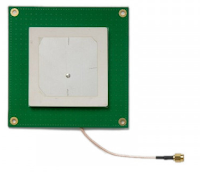UHF RFID Antennas - I - The basics
This is the first official entry to the blog!
So the other day I was watching this video and I thought "Hey I can actually do that!" (Design UHF RFID
antenna tags). So I decided the first entries to this blog would be
dedicated to UHF RFID antennas (I don't even feel qualified to qualify
that idea...).
I always found RFID technology very interesting. It's a shame that it
is really obscured, especially the UHF. One can find some applications
here and there, and many times don't even realize it's RFID. Still, I
always get the feeling that it is a highly underrated technology, I
mean, it has the potential to offer so much, but somehow, it's not so
ubiquitous as it should have been. Think about it, it's a wireless
communication system, where the mobile parts actually work without the
need for batteries, but they can send data back to a transmitter without
any local power source available to them. That's as close as we can get
to 'wingardium leviosa' in our world (Well, there's many
interesting techs out there that are rather magical, but this one is
cool).
Now I should focus on the antennas, but I thought I'd give a little
explanation behind the workings of RFID. I'm not going to be
exhaustive, if your interested in knowing more, I can
recommend reading the following book:
On the video I mentioned in the beginning, they provide a quick
explanation to how an RFID system works, check
minute 22:30. I'd only like to add a little detail that I thought missing. Actually
the description of Scotty is accurate, in the sense that the tag really
converts the RF signal to a usable DC voltage in order to power up in
the internal logic circuit to read the query info, read its
corresponding ID from memory and bias an actuator (transistor), but
then, it does not generate a signal to transmit back, as explained in
the video, the 'Tag' actually reflects the signal back to reader. This
happens as follows, the 'Reader', after sending a 'Query' to the air,
keeps an unmodulated carrier wave on the air, in the same frequency, for
a short time, this is the time needed for the 'Tag' to respond. When
this carrier wave reaches the 'Tag', it will tune/de-tune it's input
impedance of the antenna, therefore, absorbing or fully reflecting the
incoming carrier wave, actually creating what is called an ASK
(Amplitude Shift Keying) modulation that the reader can then
decode.
Of course this methodology does not allow communications with high data
rates, actually it is very constrained and only useful to send a few
bytes. Even though there have been people in the academia developing
complex modulation schemes that could be employed in passive RFID tags
and boost the available data rates. Now, I won't dig to deep into this
subject because there's a lot to explore and a lot that I don't know
about it. As is the premise of this blog, I'll focus essentially on the
antennas.
There's several antennas on both sides of the system, especially if you
starts looking at proposals in scientific publications from IEEE, but
commercially there's in essence three types of base antennas for the
'Reader' and two types for the 'Tag' antennas.
On the 'Reader' side, the antenna choice is usually a compromise
between the size and weight to the gain and bandwidth. Higher gain
antennas allow longer reading ranges for the RFID system, but gain of
antennas is intimately connected to their size, and many applications
sacrifice reading distance to have a more compact solution. The three
typical antennas found on commercial RFID products are the good old
microstrip patch antenna, either with an air core or with ceramic core
and the quadrifilar spiral antenna. Here's some examples:
On the 'Tag' side there's less variety. Even though there's a lot of
different and weird designs for these antennas, most of them are based
on the same antenna principle, only changing the shapes to conform to
different sizes, make them more square or more rectangular, or round,
etc. Most tag antennas are based around dipoles with a T-matching
network, however, there's a few variations to this rule, one is the
4-arm crossed dipole antenna found in some commercial 'Tags' as well
other more exotic antenna implementations for 'Tags' that work under
special conditions, like attached to metallic objects. Here's some
examples:
Besides the examples shown above, there's a lot of variants for all
sorts of applications, but the antenna types usually revolve around
dipoles or the more specific constructions for tags that are to be
attached to metallic surfaces.
Well, I don't feel like going further than this today. On the next
posts I'll focus on exploring in more detail the construction of some of
the antennas shown here. With the first being about the good old
microstrip patch, starting with the air core, then I'll move to the
ceramic core. Eventually I'll reach the tag designs as promised in the
beginning of this post.













Simon, who doesn't want to be on camera, is the personification of all standard engineers worldwide: "really sketchy antennas still works". No need for a PhD, just a steady soldering hand :)
ReplyDelete